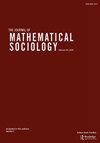An acceleration-scale model of IING’s diffusion based on force analysis
IF 1.3
4区 社会学
Q3 MATHEMATICS, INTERDISCIPLINARY APPLICATIONS
引用次数: 0
Abstract
ABSTRACT The diffusion of Internet-based Intangible Network Goods (IINGs) shows new characteristics completely different from that of traditional material products. This paper aims to establish new models to describe and predict IING’s diffusion at the aggregate level. Firstly, we transform the key factors affecting IING’s diffusion into driving forces, resistant forces, and variable forces. Secondly, we analyse the dynamic changes of these forces in different diffusion stages and obtain the acceleration model of IING’s diffusion. Then, since acceleration is the second derivative of scale, we further establish the scale model of IING’s diffusion. As the scale model can predict the number of IING’s adopters at a particular time and the acceleration model can explain the dynamic changes of scale, we combine them as the acceleration-scale model to describe IING’s diffusion. Finally, we make comparisons between the acceleration-scale model and the Bass model based on three cases. Different from the previous studies, we found that IING’s diffusion rate is asymmetric. The diffusion rate of successful IING is right skewed while the diffusion rate of failed IING is left skewed. The results also shows that the acceleration-scale model has a better predictive performance than the Bass model, no matter the diffusion is successful or failed基于力分析的ing扩散加速度尺度模型
基于互联网的无形网络商品(IINGs)的扩散呈现出与传统物质产品完全不同的新特征。本文旨在建立新的模型来描述和预测ing在总体水平上的扩散。首先,我们将影响ing扩散的关键因素转化为驱动力、阻力和可变力。其次,分析了这些力在不同扩散阶段的动态变化,得到了IING扩散的加速度模型。然后,由于加速度是尺度的二阶导数,我们进一步建立了ing扩散的尺度模型。由于比例模型可以预测特定时间ing的采用者数量,而加速度模型可以解释比例的动态变化,因此我们将它们结合为加速度-比例模型来描述ing的扩散。最后,对三种情况下的加速度尺度模型与Bass模型进行了比较。与以往的研究不同,我们发现ing的扩散速率是不对称的。成功的扩散速率为右偏斜,失败的扩散速率为左偏斜。结果还表明,无论扩散成功与否,加速度尺度模型都比Bass模型具有更好的预测性能
本文章由计算机程序翻译,如有差异,请以英文原文为准。
求助全文
约1分钟内获得全文
求助全文
来源期刊

Journal of Mathematical Sociology
数学-数学跨学科应用
CiteScore
2.90
自引率
10.00%
发文量
5
审稿时长
>12 weeks
期刊介绍:
The goal of the Journal of Mathematical Sociology is to publish models and mathematical techniques that would likely be useful to professional sociologists. The Journal also welcomes papers of mutual interest to social scientists and other social and behavioral scientists, as well as papers by non-social scientists that may encourage fruitful connections between sociology and other disciplines. Reviews of new or developing areas of mathematics and mathematical modeling that may have significant applications in sociology will also be considered.
The Journal of Mathematical Sociology is published in association with the International Network for Social Network Analysis, the Japanese Association for Mathematical Sociology, the Mathematical Sociology Section of the American Sociological Association, and the Methodology Section of the American Sociological Association.
 求助内容:
求助内容: 应助结果提醒方式:
应助结果提醒方式:


